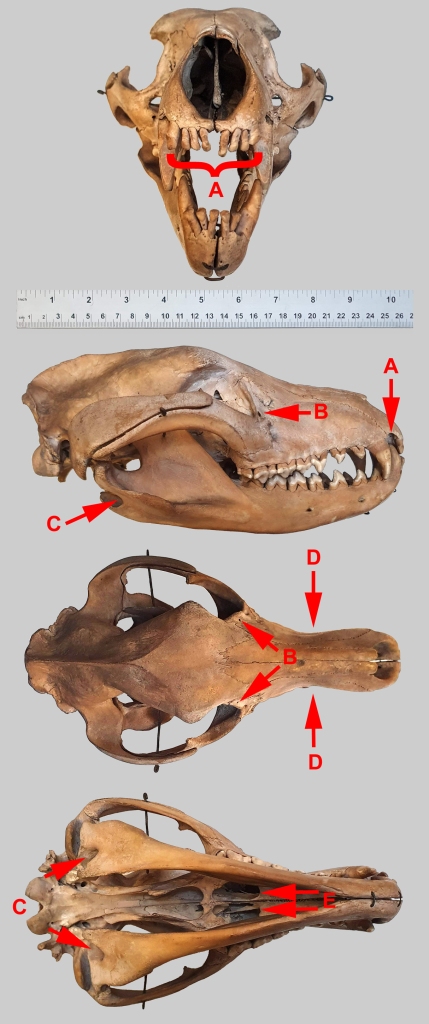Last week I gave you this rather nice skull to identify:
I was hoping that it would catch some of you out, since at first glance it looks like the skull of some kind of canid. I thought I had caught out Joe Vans, but then he noticed one of the features that sets this skull apart from dog skulls – the pinched-in section in the mid-muzzle area. Then everyone started piling in with their observations and my hopes of being tricksy were fully dashed.
This is of course the skull of that paragon of convergent evolution, the Thylacine (AKA the Tasmanian Wolf or Tiger) Thylacinus cynocephalus (Harris, 1808).
I’ve written fairly extensively about convergent evolution between Thylacines and canids before, when I worked at the Grant Museum of Zoology, so I won’t go into huge detail here, but I will give you an annotated image showing some of the features to look for that help distinguish these marsupial carnivores from their placental dopplegangers:

B= Lacrimal duct on outside of orbit
C= Inwardly deflected angular process
D= “Pinched” midsection of rostrum
E= Palatal vacuities
These physical differences between the Thylacine and the Eutherian canids are features common to many marsupials and they act as reminders that evolution is limited by what it has to work with. At the most fundamental level that means DNA.
In recent years the methods for successfully extracting and sequencing DNA from museum specimens has moved on in leaps and bounds. In 2018 these advances allowed the Thylacine’s genome to be assembled, allowing comparison with their morphologically similar, but taxonomically distant counterparts.
The team that did this went looking for similarities between protein coding genes in the different lineages at first, to understand what was driving the morphological convergence – but it seems that they were looking in the wrong place.
When they looked more closely, it was actually in the cis-regulatory elements (the non-coding DNA that used to be considered “junk”, but which is now recognised as playing a vital role in regulating development) that genetic convergence was seen. It turns out that these elements were also driving convergence in brain development between Thylacines and canids.
It seems that protein coding genes are quite stable – if they mutate they usually stop working properly, so the mutation often doesn’t persist. But mutations in cis-regulatory elements can change gene expression with less risk of catastrophic consequences. Unsurprisingly that means they are increasingly being seen as the main drivers in evolutionary adaptation. If you’re interested in finding out more about this fascinating research, a pdf of the 2019 paper on Thylacine/canid genetic convergence by Feigin, Newton & Pask can be accessed here.
I hope you enjoyed this short trip down the road of convergent evolution, with a hat-tip to the genetic drivers involved.


You guys in Dublin have some seriously cool stuff in your collections! For a mammal skull collector, the thylacine is a Holy Grail species, like a Great Auk would be for someone like me ;).
We do. This is actually the skull from a mounted skeleton. There were three additional skulls and a taxidermy specimen in the same display case this came from and we have more in storage. Our collection is incredible! Sadly we don’t have any complete Great Auk skulls though, just a lot of disarticulated bones and fragments.
I’ve never been in Ireland so far but if I ever get there I’ll visit your museum for sure!
Make sure you let me know if you do come and visit!